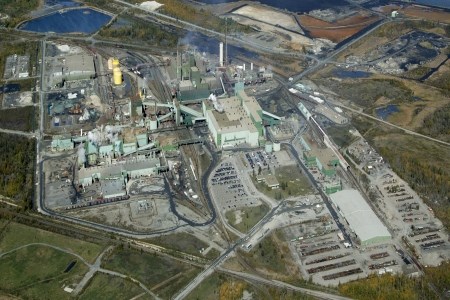Though the price of gold is providing it with a financial shot in the arm, the City of Timmins still continues to look for ways to cope with the closure of Xstrata’s Kidd Metallurgical Site a year after it was first announced.
“There are good things happening here with construction in educational institutions and retail, and that’s going to help take the sting out of it, for sure,” says Mayor Tom Laughren.
“But this is something we need to contend with that’s going to have a ripple effect in our community for some time to come.”
The May closure put some 670 employees out of work while the processing was shifted to the company’s Horne smelter in Rouyn-Noranda, Que. The move was an enormous blow to the city, felling not only employment numbers but also tax assessment funds. The closure of the facility translates to an annual tax loss of $4 million to the city.
While there continues to be an upswing in local construction with new seniors’ residences, hospital additions, and educational facility upgrades, it will be some time before the tax difference can be made up. For a smaller community like Timmins, the short-term impact will be “significant.”
Similarly, the broad number of gold mines and related exploration projects through the region will find some of the former Met Site workers with new jobs, though there are many who will be forced to look elsewhere, says Laughren. Some of the laid-off staff have returned to school to obtain a trade.
“Even the gold processing part obviously does not employ the same people that were needed at the metallurgical site, especially when you look at the smelter and the zinc section. Those were two heavily laden labour forces.”
A research study commissioned by the Canadian Auto Workers suggests the closure led to a combined loss of 4,428 direct and indirect jobs, with a resulting loss of $237 million in wages.
To try and shore up those numbers, the province has provided the city with $225,000 to fund a study to determine the best use of the site.
Although hopes were initially placed on potentially making use of the site to process material from the Ring of Fire in the James Bay lowlands, the scope of the study has shifted given the extended window of time expected to be needed for a mine, and the immediate need to preserve the Met site’s infrastructure.
The focus is now moving towards what Laughren refers to “a couple of mining-related opportunities,” though he is hesitant to divulge who or what that entails. The study is expected to be released by late December or early January.
Despite this official stance, some in the region hold onto hope that the area could yet play host to Cliffs Resources’ chromite processing facility, whose location is still anybody’s guess.
When asked by Northern Ontario Business whether the Met Site is in the running, Northern Development, Mines and Forestry Minister Michael Gravelle said it would be unfair to identify any of the shortlisted six communities.
“We worked very closely with Mayor Laughren and with the community while we went through the very real difficulties associated with the Xstrata decision to close the Met Site. We want to see that site being used in a very positive, beneficial way as well and we continue to work Mayor Laughren closely in that regard.”
The closure has also become a lightning rod for criticism over the high price of industrial power in Ontario, something Laughren himself has openly said to be a significant problem for keeping industry in the North and was likely a factor in Xstrata’s closure.
Other political parties, buoyed by a groundswell of support from Timmins’ municipal and union leaders, have charged that the province needs to reform its stance on natural resource processing.
In April, Timmins-James Bay NDP MPP Gilles Bisson put forward a private member’s bill to amend the Mining Act to allow the province to control whether ore mined in Ontario will be processed in Ontario. It was defeated in second reading, prompting Bisson and provincial party leader Andrea Horwath to decry the government as being willing to rush to the aid of southern Ontario’s automotive industry while allowing the North to wither.
Gravelle defended the government’s handling of the issue, saying it would be irresponsible and unwise for Ontario to demand that ore mined in the province has to be processed here as well. Processing facilities in Ontario often handle a great deal of work from other mining jurisdictions, and putting in place such measures could spark retaliatory action from these areas and threaten even more jobs in the North, he argued.




